Concerns about nutrients
Nitrogen and phosphorus are essential for healthy plant and animal populations; however, elevated concentrations of these nutrients can degrade water quality. Excessive nitrate in drinking water can result in "blue-baby syndrome," which causes oxygen levels in the blood of infants to be low, sometimes fatally. Elevated nitrogen and phosphorus concentrations in surface water can trigger eutrophication, resulting in excessive, often unsightly, growth of algae and other nuisance aquatic plants. These plants can clog water intake pipes and filters and can interfere with recreational activities, such as fishing, swimming, and boating. Subsequent decay of algae can result in foul odors, bad taste, and low dissolved oxygen in water (hypoxia). Excessive nutrient concentrations have been linked to hypoxic conditions, such as those found in the Gulf of Mexico, which can harm fish and shellfish that are economically and ecologically important to the Nation. High nutrient concentrations also are believed to be one cause for the growth of the dinoflagellate Pfiesteria, found in Atlantic coastal waters. This form of algae is potentially toxic to fish and other organisms, including humans.
Societal concerns for the quality of our water resources continue, as many of the Nation's streams and coastal waters do not meet water-quality goals. States report that 40 percent of the waters they surveyed are too contaminated for basic uses, such as fishing and swimming. Some progress has been made since passage of the Clean Water Act in 1972. Since the early 1970s, private and public sectors have spent more than $500 billion on water-pollution control, much of which has been directed toward municipal and industrial point sources.(1) Although some violations still occur, this legislation has had a positive effect on limiting contaminants from point sources entering streams.
Progress in cleaning up contamination from point sources has not yet been matched by control of contaminated runoff from nonpoint sources, including fertilizers and pesticides applied in agricultural and urban areas, and nutrients from human and animal wastes. The challenges are great because nonpoint sources are ubiquitous yet highly variable causes of water-quality problems, making them difficult to evaluate and control.
Beginning in the early 1990s, widespread environmental and public-health concerns resulted in a Federal water-quality initiative to work with the Nation's farmers to protect surface water and ground water from nutrient and pesticide contamination. To address these national concerns, nutrients and pesticides were two of the first water-quality issues evaluated by the NAWQA Program. This report, which presents regional and national insights on these chemicals, is based on a compilation of findings from the first 20 NAWQA Study Units.
